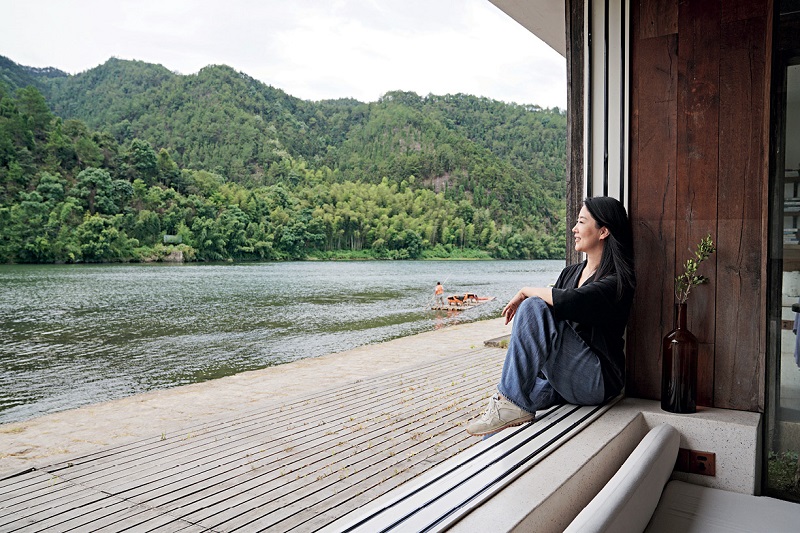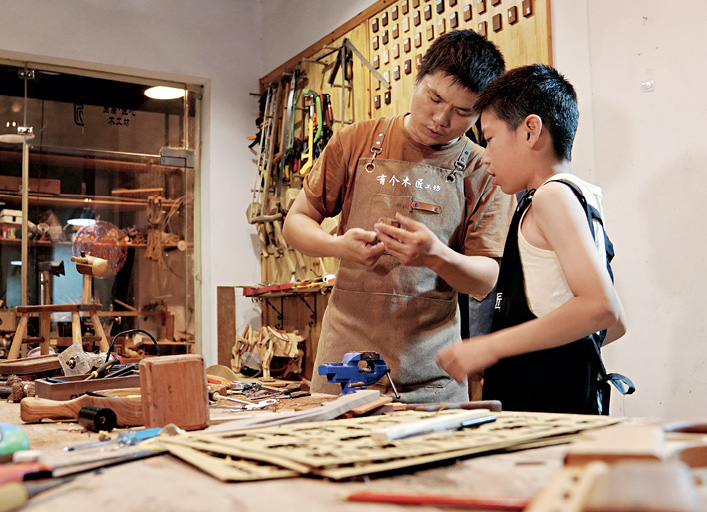Zhejiang’s Green Rural Revival Program has improved the local eco-environment and quality of life.

Ye Lifang at her homestay in Yantou Village, Bihu Town, Lishui City.
The Guyan Huaxiang literally “ancient weir and picturesque town” scenic area is 20 km away from the center of Lishui City in Zhejiang Province. It is an idyllic region that features Chinese-style buildings and unblemished natural landscape. The Oujiang River splits the area into two. Guyan, on the north shore, refers to Yantou Village of Bihu Town, which has a thousand-year-old canal weir and ancient camphor trees. Huaxiang, on the south shore, refers to Dagangtou Town, a beautiful painting town that is home to the vivacious Lishui Barbizon school of painting.
Guyan Huaxiang is a paradise for tourists, painters and photographers. Zhang Weiwu, Chinese Communist Party secretary of Yantou Village , said that the Green Rural Revival Program, put forward in 2003 by Chinese President Xi Jinping when he was Party secretary of Zhejiang Province, has hugely contributed to the ecological progress in the area.
“Looking back, this program, which started with the cleaning up of villages, marked a turning point for the development here,” said Zhang. The man, who has been a village leader for 25 years, has been a witness to the changes brought about by the project, and is overwhelmed with emotion when recalling them.
Over the past 20 years, the scope of the program has expanded from 10,000 demonstration villages to all administrative villages in Zhejiang. In 2018, Zhejiang Province was recognized with the Champions of the Earth award, the United Nation’s highest environmental honor, “for the transformation of a once heavily polluted area of rivers and streams,” by the UN Environment Program.
According to Huang Zuhui, chief expert of the China Rural Development Research Center of Zhe-jiang University, the Green Rural Revival Program has changed the look of Zhejiang’s rural areas. “It has changed the rural housing environment, and also mobilized the villagers to play an active role in the management and maintenance of rural facilities. It also changed the business environment, making the village a place of recreation for urban residents, so as to boost the rural economy, through the integrated development of industries and the integrated development of cities and countryside. All of this has provided employment opportunities and increased incomes for farmers, and had a significant effect on pursuit of common prosperity,” he said.

Yang Xiangjun shows a child how to make small decorative wooden objects in his workshop, on July 4, 2023.
Environmental Improvement
In 2005, Yantou Village, which was dotted with cesspits due to pig farming, was included in the first batch of villages to be renovated under the Green Rural Revival Program. “The first step was to clean it up,” said Zhang.
Led by the village officials, the villagers began to refurbish roads, water supply, toilets, and houses, and removed more than 200 structures of pig and cow pens and open-air cesspits. But not everyone could understand the value of this operation, especially those who relied on raising pigs and cattle for their livelihoods.
Zhang said that the villagers were not satisfied with the dirty environment, but were worried about losing their livelihoods. To solve the problem, the village applied for government subsidies, while asking its residents to switch from raising pigs and cattle to growing tea and vegetables, and start agritainment businesses. These industries are based on local development conditions, do not pollute the environment and bring real added value.
“The key to gaining the support of villagers is to offer them tangible benefits,” said Zhang. The environmental cleanup has made the village much more beautiful, and the agritainment business has brought residents a considerable increase in income. Thus more and more villagers began to support the transformation of the village.
The village has continued to upgrade its environment by paving roads, treating garbage, improving public sanitation, and renovating buildings. The living environment has undergone momentous changes.
The changes have not only improved the quality of life but also created business opportunities.
Ye Lifang, who had been in the hotel catering business in Hangzhou City of Zhejiang Province for more than 10 years, built the first homestay in Yantou in 2017, which faces the Songyin Stream Scenic Area and is adjacent to the 1,500-year-old Tongjiyan Irrigation System. Attracted by the natural beauty, guests quickly began to arrive. Later, she opened a bookstore, showroom of oil painting, cafe, and teahouse in the village, providing employment for over 30 villagers. Today, the annual revenue of her projects has reached RMB 2.6 million (US $361,000).
The income increase helped the villagers see the concrete benefits of environmental management. More villagers began to clean their courtyards, beautify the surrounding environment, and open farmhouses and homestays. Today, Yantou Village has more than 30 homestays and farmhouses, and receives more than 300,000 tourists a year, with an annual turnover of over RMB 10 million (US $1.38 million), and per capita annual income of RMB 46,000 (US $6,389).
The Guyan Huaxiang scenic area is just one example of the development of countless villages in Zhejiang Province. In 2019, Zhejiang became the first province to be recognized as an ecological province, and has since ranked first in the country in terms of rural habitat. In terms of building a beautiful countryside, by the end of 2022, Zhejiang had 70 model districts, 724 model towns, 743 scenic spots, 2,170 special villages and more than three million beautiful homes.
“The improvement of the rural living environment is the most direct and visible change that the Green Rural Revival Program has brought to Zhejiang’s rural areas. This transformation has promoted green development, allowing villagers to strive for a win-win situation between economic development and ecological progress,” said Lan Hai, deputy director of the Publicity Department of Lishui City.

The Barbizon gallery in Guyan Hua-xiang, Lishui City, Zhejiang Province, attracts painters and tourists.
Industrial Transformation
The Green Rural Revival Program not only improves the environment of tens of thousands of villages, but also effects changes in the development mode of rural industries.
On the other side of the Oujiang River lies the Dagangtou and Hebian villages of Dagangtou Town, which are important parts of the Guyan Huaxiang Scenic Area.
These two villages have attracted countless painters since the 1980s thanks to their beautiful landscapes. Visitors are fascinated by the museums, galleries and painting institutes, which can be seen everywhere, by its camphor trees, docks, and streets, as well as the guest houses, restaurants, and shops decorated with plants and flowers.
Yang Xiangjun opened a wooden handicraft shop in Hebian Village, in which he sells wooden ornaments. The shop was the site of a wood processing factory that had once operated for more than 20 years. The past and present of this small shop reflect the past and present of the painting town, which can be described as worlds apart.
In the 1990s, in order to pursue rapid economic development, a large number of local people joined the wood processing industry and more than 140 wood factories were established in the town. Yang’s family was among them. In his memory, at that time, the roads were full of piles of wood, and wastewater from the wood-boiling pits spilled into the street. There was no advanced dust removal equipment, forcing people to keep their doors and windows closed all year round. “It was a dark time,” he said.
After the launch of the Green Rural Revival Program, the region began to improve the environment, relocate wood processing factories and develop tourism.
“At that time, the government called for transformation, and we were wondering if that was good or bad for our business,” Yang said, adding that in the end, the transformation ushered in a turning point for his business. In 2015, Yang’s family moved the factory to the Bihu Industrial Zone, Liandu District in Lishui City. In order to adapt to the trend of green development, the factory has stopped making furniture and instead produces biomass pellets for fuel. Because the products are green and environmentally friendly, the market demand has been increasing, and the annual output has rapidly increased from the initial 10 tonnes to 110 tonnes.
As the Barbizon oil painting industry in the village replaces wood processing, new business forms represented by homestays, cultural and creative stores, and coffee shops are booming. In 2017, Yang transformed the former factory into a homestay and opened a woodworking workshop, which became a popular place in Guyan Huaxiang.
“Now the annual income of the homestay business is between RMB 200,000 (US $27,778) and RMB 300,000 (US $41,667), and the business of the wood workshop is getting better and better,” Yang said. “What’s more, our children no longer have to live in dusty conditions.”

Farmer painter Lei Chunying works in her studio in Dagangtou Village, on July 4, 2023. Photos by Yu Xiangjun
Change of Mindset
In addition to the appearance of the countryside, the Green Rural Revival Program has profoundly changed the mindset of the inhabitants. “It has revolutionized the thinking of the villagers,” said Lan Xiaoqing, Party secretary of Hebian Village.
Lei Chunying is the most popular farmer painter in Dagangtou Village. “I used to work in a local wood factory. Many painters came to our village to draw real life, and I loved to watch and learn from them,” she said. Lei uses the landscapes of the village as inspiration for her designs, for example, the wharf, the white sails, the old trees and the pavilions. Now, her paintings are priced at RMB 200 (US $27.78) each, with frequent online orders. In her 10-square-meter studio, she sketches the beauty of her village and her happy days.
Every morning, by the Oujiang River, Lan Xiao-qing greets the female river protection team. Composed of 20 female villagers aged 20 to 60, the team is responsible for detecting dangers and collecting garbage. These women have been working to keep the water clean for seven years.
“Previously, environmental cleaning was done as a passive response to inspections, whereas now, doing a good job in environmental cleaning has become a habit and voluntary action of local people,” said Lan.
Huang Xiaohua originally thought that he would inherit the family skills and become the fourth-generation ferryman in the Oujiang River. However, as Barbizon culture took root in Guyan Huaxiang, he embarked on the path of art.
Today, as a famous Barbizon painter, he has established an art community in Guyan Hua-xiang to share theoretical knowledge and painting techniques for free among painting enthusiasts. “Common prosperity is not only the growth of material wealth, but also intellectual and cultural satisfaction. I absolutely want to contribute to improving the artistic literacy of villagers,” he said.
The change in villagers’ way of thinking brought about by the Green Rural Revival Program has given deeper meaning and lasting vitality to building a beautiful countryside to live in, according to Gu Yikang, chief expert of the Zhejiang Rural Revitalization Institute. “With the strengthening of the awareness in community of shared interests, villagers increasingly realize that a beautiful countryside can lead to a happy life."